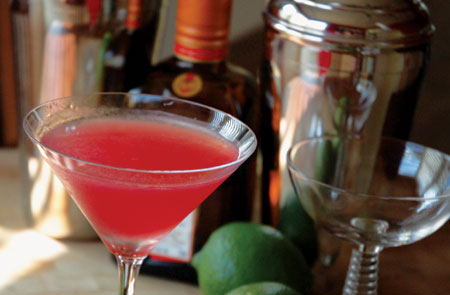[UPDATED] My turn to mix last night, and we paid a long-overdue visit to a true classic. I like Martinis, but we shouldn’t forget the Martinez, a great drink in its own right, and a nearly-forgotten cocktail that deserves a lot more recognition.
This cocktail goes as far back as the first-ever bartender’s guide/cocktail recipe book, Professor Jerry Thomas’ The Bon-Vivant’s Companion, or How to Mix Drinks, first published in 1862. It’s been called the drink that gave birth to the modern Martini, although it bears little resemblance these days; perhaps an ancestor would be a better description. Thing is, nobody after Thomas seemed to agree on a recipe.
Thomas called for twice the amount of sweet vermouth as gin, others called for twice the amount of gin. Patrick Gavin Duffy, in his seminal bar guide, called for dry vermouth instead of sweet, and whoever made that initial substitution in a Martinez pushed the drink on its way to being a Martini. I opted for a cross between two versions I found at CocktailDB.com, balancing the gin and the vermouth, which I wobbled by using a powerful vermouth — Carpano Antica Formula, my favorite sweet vermouth (full of herbs, spices and bitter notes).
Here’s the recipe from that 2006 version, the version we like now, and Professor Jerry Thomas’ original (it’s arguable that he created this cocktail, but there’s no solid evidence).
The Martinez Cocktail
(CocktailDB mélange)
1-1/4 ounces gin.
1-1/4 ounces sweet vermouth.
2 dashes maraschino liqueur.
1 dash Angostura bitters.
Stir with ice for no less than 30 seconds; strain into a cocktail glass.
Garnish with a lemon twist.
Here’s the version we like to make in 2010. We like 2 dashes of Angostura Orange Bitters, but Seattle bartender Jamie Boudreau recommends 1 dash each of Regans’ Orange Bitters No. 6 for the spice, and Fee’s West Indian Orange Bitters for the citrus.
The Martinez Cocktail
(modern version)
2 ounces Hayman’s Old Tom gin. (Or Plymouth if you can’t get Old Tom.)
1 ounce sweet vermouth.
1/4 ounce maraschino liqueur.
2 dashes orange bitters.
Stir with ice for no less than 30 seconds; strain into a cocktail glass.
Twist a lemon peel over the drink and garnish with the twist.
Now, the original version from 1862. A “pony” is one ounce, and we’re interpreting the amount “a wineglass” to be two ounces.
The Martinez Cocktail
(Professor Jerry Thomas’ version, and the first published one)
(Use small bar-glass.)
Take 1 dash of Boker’s bitters.
2 dashes of Maraschino.
1 pony of Old Tom gin.
1 wine-glass of sweet Vermouth.
2 small lumps of ice.
Shake up thoroughly, and strain into a large cocktail glass.
Put a quarter of a slice of lemon in the glass, and serve.
If the guest prefers it very sweet, add two dashes of gum syrup.
We’ll probably try this with the good old standby, Martini & Rossi. Boker’s Bitters was a stomachic bitters which didn’t survive the 19th Century, and seemed to be Professor Thomas’ favorite. Here’s a scan of an old advertisement for Boker’s Bitters from the New York Weekly Tribune, April 30, 1879.

Old Tom gin was a sweetened gin, and if you can’t find any and wish to approximate that add a couple dashes of simple syrup (“gum syrup” was simple syrup with gum arabic added).
Obviously you can’t get the original item anymore, but you can make a quite reasonable facsimile with this recipe, a modern interpretation by Dr. Cocktail. But let’s digress for a moment about Boker’s Bitters … what did it taste like? As this 2007 article tells us, for a long time no one really knew.
Until about a year ago there wasn’t a person alive who knew what Boker’s bitters truly tasted like. But then a man turned up at the London Bar Show with a finger of the old stuff to share. Made using cassia, cardamom, and bitter orange peel, Boker’s was once swirled with brandy, orgeat syrup, and lemon peel in a cocktail known as the Japanese. The company disappeared a century ago in the wake of legal changes that outlawed many bitters, and it’s impossible to find anything but empty bottles today. “It was a tiny amount of original Boker’s—no one knew it existed,” says Charlotte Voisey, a champion British bartender who has created cocktail lists for The Dorchester in London and New York’s Gramercy Park Hotel. In the end she declined to join the tasting line. “I didn’t know who he was,” she says, “and I didn’t see it as my place to ask for some. It was that sacred.”
At Tales of the Cocktail in 2008, I got to taste some, one tiny drop on the back of my hand. It was extraordinary.
After much research Dr. Adam Elmegirab has come up with his own commercially produced version of Boker’s Bitters, which may help take your Martinezes and other classic cockails back to the 19th Century.







